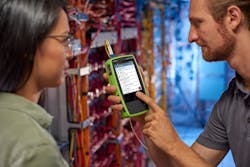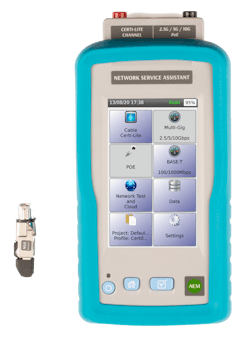By Patrick McLaughlin
For the manager of an enterprise network’s physical layer, the performance of the network’s WiFi infrastructure can be a blind spot. Prior to the installation or upgrade of a wireless LAN, a wireless expert can conduct a site survey, which includes the use of software to generate a heat map projecting the wireless coverage based on where access points will be placed. The choice of using the 2.4- or 5-GHz operating window, and the channels within each window, affects coverage, as do the locations of objects that are likely to obstruct signal.
Once the wireless LAN is in everyday operation, it often is like other parts of a network in that users and administrators alike may assume its performance will continue unabated. When that is not the case, and it becomes necessary to verify wireless LAN performance, technicians who work on a network’s physical layer can turn to some familiar brand names for that purpose.
For example, Softing offers the WaveXpert, which it describes as a wireless LAN sniffer for 2.4- and 5-GHz networks operating according to the IEEE’s 802.11a/b/g/n/ac specifications. The company explains that the WaveXpert “can be used to record and analyze wireless LAN transmissions, with Wireshark, that are exchanged between two or more participants. Wireless LAN devices whose transmissions are recorded are, for example, mobile devices such as notebooks or smartphones, but also permanently installed equipment such as access points, wireless LAN printers or PCs with wireless LAN cards.”
It is available in two versions, one of which operates at 2.4 and 5 GHz, including 4 channels with 20/40/80 MHz and up to 3x3 MIMO (multiple-input multiple-output). The other operates at 5 GHz, including 4 channels with 20/40/80/160 MHz and up to 4x4 MIMO.
“Not only user data, but also management and control information is received loss-free and stored for further analysis,” Softing explains. “This unit operates in passive mode only. Wireless LAN transmissions are only received and nothing is sent.”
The device has a Thunderbolt interface and is designed as a peripheral device for PCs.
An able assistant
AEM also offers wireless LAN verification capability on several of its test devices, including its recently introduced Network Service Assistant (NSA). The company says the NSA “represents a new category in testing with Qualification+, bridging the divide between qualification and certification in a single multifunction link tester.
“The NSA was designed with IT managers in mind, due to the diversity of technologies they are responsible for overseeing, particularly with the proliferation of smart building technologies,” AEM continues. “We took a unique approach to provide a breadth of test function that is unmatched in the industry, and thoughtfully designed to keep the price point representative of a significant cost savings from having to purchase multiple pieces of test equipment. The NSA is modular and allows users to pick and choose the exact testing function they need.”In addition to testing copper and fiber-optic cabling circuits, the NSA provides signal-to-noise ratio (SNR) based testing of link speed, while under both traffic and Power over Ethernet load. “This provides a real-world scenario of link performance, with reporting of SNR and margin, and pair-to-pair reporting at 1, 2.5, 5, and 10 Gigabit Ethernet,” AEM explains. Additionally, an in-depth PoE test suite supports IEEE 802.3af/at/bt, as well as UPoE. It reports current, voltage, and wattage at the jack where a powered device will deploy. It also supports sustained PoE load monitoring.
PoE and multi-gig speeds like 2.5- and 5-Gbits/sec commonly support wireless access points. AEM points out, “Network connectivity testing, be it wired or wireless, is a cornerstone need for users. The NSA supports both.
“Wired testing includes device discovery, with drilldown to understand who and what is on the network. Switch detail including slot/port/VLAN and VLAN usage breakdown provide quick visibility into the network configuration. On-board troubleshooting tools such as ping and traceroute help to identify problem domain.
“On the wireless side, the NSA supports SSIDs [service set identifiers], along with their channel and signal strength. Users can login to any SSID and ping to ensure reachability. Roaming signal strength allows users to walk a building to identify SSIDs’ signal strength, aiding in identification of access point deployment and troubleshooting.
“NSA’s auto-discovery will display all selected SSIDs and their associated RSSI [received signal strength indicator]. This is useful in determining if the WiFi network to which the user is trying to connect has sufficient signal strength.”
The NSA also can determine WiFi dead zones by roaming to check RSSI values in different locations. It can connect to any SSID using the appropriate credentials for that network.
The NSA provides what AEM calls Certi-Lite (“certification light”). The company explains, “Certi-Lite performs an ANSI/TIA-1152-A-compliant single-ended cable test for Cat 3 to Cat 6, with a simple pass/fail indication. This provides you with assurance of cabling link integrity to support your requirements. The NSA performs this test using a small passive termination at the remote end, which helps to significantly reduce the overall cost of the test equipment when compared to traditional cable certifiers.
“For cable contractors, a regular dual-ended certification test is necessary for new installations for cable manufacturers’ warranty purposes. For network owners and those who do not have a requirement for dual-ended certification, the NSA’s Certi-Lite capability is a perfect tool for qualifying existing cabling for its suitability for new applications, particularly smart buildings where PoE will be heavily used.”
Scoping the field test
Wireless LAN verification capabilities are also built into NetAlly’s EtherScope nXG Portable Network Expert. The EtherScope nXG was launched in late 2019, at which time NetAlly said it was “the first handheld tool to offer a single user interface that fully integrated both wired and wireless network test data,” adding that it “dramatically increases network visibility, accelerates and simplifies testing, and simplifies team collaboration.” It allows users to identify wireless clients not just by MAC address, but by IP, name and type, NetAlly said.
According to the company, the tester offers a wide range of capabilities and characteristics including the ability to “assess support for NBase-T, 10G, WiFi 5/WiFi 6, with advanced Android-based troubleshooting apps and purpose-built test hardware.” Additionally, NetAlly says, “Users can dive deep to verify, troubleshoot and document complex networks with multiple VLANs and WiFi SSIDs, or take advantage of out-of-the-box autotests that require minimal skill and training.
“With WiFi air quality tests for over-subscribed channels, WiFi channel utilization analysis, and network discovery, EtherScope nXG can help prove ‘it’s not the network’ or pinpoint root cause faster than other non-integrated methods,” the company adds. Additionally, the tool can discovery security risks through its network discovery technology, which identifies unknown switches, hidden SSIDs, and probing WiFi devices, while categorizing devices by security status and detecting rogues.
In spring 2020, NetAlly introduced the version 1.2 software for EtherScope nXG; the software includes the AirMapper Site Survey app as well as other features. “With AirMapper Site Survey, EtherScope nXG users can now quickly and easily gather location-based WiFi measurements and create visual heat maps of key performance metrics in the Link-Live Cloud Service,” the company says, adding that the capability is ideal for quick site surveys for new deployments, validating changes, and quick performance verification.
“It’s nice that there are no other hardware requirements needed,” adds Badman. “Site surveying is just one more tool in the inventory of the EtherScope nXG’s capabilities.”
A more recent upgrade to the EtherScope nXG introduced the LANBERT Performance Test App. James Kahkoska, NetAlly’s chief technology officer, explained the app “provides a flexible, easy way to validate the quality of ‘dark media’ and media components, such as SFPs, wall and patch panels, and patch cables. LANBERT sends network traffic between NetAlly testers, devices capable of Layer 1 loopaback, or a media physical loopback.
“In a single hour, more than 53 billion frames, at 10G, are sent and received from both ends, full duplex. LANBERT can detect if even a single bit is corrupted,” Kahkoska said. “An additional advantage is that LANBERT can be used to ‘soak test’ the media over many hours. A 24-hour test, with more than 1.28 trillion frames at 10G, may reveal that a conveyor belt static buildup corrupts the media every couple of hours, or where the humidity is low, for example. Seeing the errors graphically trended in time, with the ability to zoom in on any error with a 1-second granularity is a valuable tool in getting to the root cause of the corruption.”
An expression commonly used among information and communications technology (ICT) professionals is, “Wireless, isn’t.” The meaning, of course, is that the cabling “backhaul” is a critical element of a wireless network. With that being the case, it is fitting that the ability to troubleshoot, verify, and otherwise measure wireless LAN performance is now integrated into tools that test wired networks.
Patrick McLaughlin is our chief editor.
About the Author
Patrick McLaughlin
Chief Editor
Patrick McLaughlin, chief editor of Cabling Installation & Maintenance, has covered the cabling industry for more than 20 years. He has authored hundreds of articles on technical and business topics related to the specification, design, installation, and management of information communications technology systems. McLaughlin has presented at live in-person and online events, and he has spearheaded cablinginstall.com's webcast seminar programs for 15 years.



